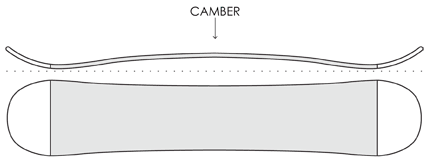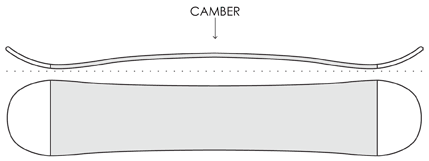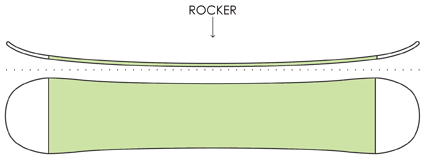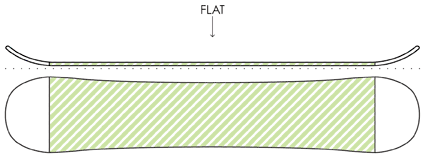What is Ski & Snowboard Rocker & Camber?
In 2003, we had one rockered option available - the beloved Volant Spatula. Now we offer hundreds of various rockered models in our rocker skis and rocker snowboards categories for every level of rider. We've been amped for years on the concept and can't wait for everyone to experience a rockered ride. This article describes exactly what rocker is and what type is best suited for your riding style and terrain.
There are many terms for rocker out there, like reverse camber and early rise. That is why we are here to summarize it in more general terms. Tune in as we break it down real simple.
What is Ski & Snowboard Rocker?
Rocker is a "profile" of skis and snowboards that is opposite of traditional camber. There are three main types of ski & snowboard profile: camber, rocker, and flat. Many modern shapes use a combination of more than one of these. Although camber has been around since long before rocker, we classify it as a type of rocker for purposes of simplicity. Rocker is also known as reverse camber, so think of camber as reverse rocker.
These three profiles - camber, rocker, and flat - are combined in an infinite number or ways in today's ski and snowboard shapes. It's common for a freeride ski to have a rockered tip, camber underfoot, and a flat tail. It's not unusual for a snowboard design to use double camber (one under each foot) with rocker at either end. Shapes continue to progress each season, with the end result being better skis and boards for every application.


How to Choose Ski Rocker Type
How to Choose Snowboard Rocker Type
Ski & Snowboard Camber
This is the traditional profile for skis and snowboards. Camber is a slight upward curve in the middle of a ski or board, with the contact points - where an unweighted ski or board contacts the snow - close to the ends. Camber requires more precise turn initiation and offers superb precision with plenty of power on groomed terrain and harder snow. The rider's weight puts an even and concentrated pressure on the edge from tip to tail, resulting in increased edgehold and better "pop." Racers and high level park riders often prefer camber. Cambered skis are great for skiers riding the hard snow of Vermont and the East Coast, as well as those look for a more traditional feel.


Ski & Snowboard Rocker
Rocker (also called reverse-camber) is just as it sounds – camber turned upside down. All skis and snowboards, rockered or cambered, when put on edge and weighted in a turn achieve reverse-camber. Cambered skis and boards produce more pressure on the snow at the tip and tail since they have to flex further to achieve this curve. The term rocker is borrowed from watersports where rocker is common. Rocker skis and snowboards offer superior float in the soft snow and increased ease of turn initiation with less chance of "catching" an edge. This is great for skiing deep powder in areas like British Columbia and ski areas in Colorado. As skis in general get wider, rocker helps keep the new shapes maneuverable for a wider range of skiers. Wide ski and board shapes designed primarily for powder are often rockered.


Flat Skis & Snowboards
Flat is often found between the tip and the tail of the ski/snowboard. Flat means flat – if you lay the ski or board on a table with no weight on it, there won’t be any space between the base and the table. Completely flat technology is more common with snowboards than with skis, and it is much more common to see skis that are almost flat underfoot with rocker in the tip and sometimes tail. Flat makes easy transitions, with better edge grip than rocker and better maneuverability than camber.


Benefits of Rocker
Rocker offers increased float in the powderWith rocker, your tips will float up in powder and crud. The feel is smooth and just like when you surf, wakeboard or waterski, rocker helps you to stay buoyant and on top of the snow. On skis, there's no need to do all that ridiculous bouncing and leaning back to keep your tips from going under. On a snowboard, your tip sits up higher out of the snow so you can avoid those face plants over the nose. You're able to maintain a more balanced riding stance which saves energy and improves your reaction time.
Rocker is more maneuverableRocker brings the tip and tail up and off the snow, shortening the contact length of the edges and making turns easier. Your ride becomes more nimble and maneuverable, allowing your to pivot and "slarve" without catching edges. You can slash the snow, slide sideways to scrub speed, smear and butter turns. The increased mobility works great when you are in the trees or tight chutes.
Rocker in the parkWith rocker technology, your skis/board are pre-pressed which makes riding presses in the park easier. The less-catchy nature of a rockered ski/board allows you to initiate your spins early and gives you greater ability to recover from off-axis landings and under-spun airs.
All mountain rocker
With the exception of icy, pure competition race envrioments, there are rocker profiles meant to excel in every type of skiing and snowboarding. It has become quite normal for manufacturers to design all mountain skis and snowboards that incorporate some kind of rocker. Everyone can ride rockered skis and snowboards and have fun. That's the beautiful thing about rocker technology. You can be a beginner or advanced rider, young or old, and benefit from riding rocker skis or snowboards.
Testing & Renting Skis & Snowboards
It’s easy to obsess over every measurement and material of different ski and snowboard models when looking at them on a computer screen, but there is absolutely no substitute for some real-time on the snow. So, once you’ve narrowed down the candidates and you’re ready to choose your next model, it’s time to get on snow. Renting or demoing skis and snowboards is the only true way to get a feel for how they ride, and if they suit you.
Check out evoRentals, our industry-leading ski and snowboard rental experience at our locations, which offers a wide variety of the latest models.
Learn More With Our Other Ski Guides:
Skis - Size Chart & Buyer's Guide
Skis - Kids' Size Chart and Buyer's Guide
Skis - Rocker Technology Explained
Ski Bindings – How to Choose & DIN Setting Chart
Ski Boots - Sizing & Buyer's Guide
Ski Boots - Boot Sole & Ski Binding Compatibility
Ski Boots – How to Make Your Boots Fit Better
Ski Poles - Size Chart
Skiing - Beginner Skiing Tips
Skiing - How to Fly With Skis
Skiing - How to Get in Shape
Ski Maintenance - Base Repair
Ski Maintenance – How to Store for the Summer
Ski Maintenance – How to Tune
Ski Maintenance – How to Wax
Outerwear - What to Wear Skiing
Outerwear - How to Wash & Waterproof
Outerwear - Regional Ski Guide
Gloves & Mittens - How to Choose
Goggles - How to Choose
Goggles - Wearing Goggles with Glasses
Helmets - How to Choose & Fit Guide
Footbeds - How to Choose
Ski Socks - Sizing & Buyer's Guide
Travel - How to Fly with Skis
Alpine Touring Skis - How to Choose
Avalanche Probes - How to Choose
Backcountry - Choosing an Avalanche Airbag Pack
Backcountry - Choosing an Avalanche Beacon
Backcountry - Climbing Skins Size Guide
Backcountry - Dynafit / Tech Binding Basics
Backcountry - How to Buy Alpine Touring Bindings
Backcountry - How to Buy Alpine Touring Ski Boots
Backcountry - How to Choose an Avalanche Shovel
Backcountry - How to Choose Climbing Skins
Backcountry Backpacks - How to Choose
Backcountry Basics - How to Get Started
Learn More With Our Other Snowboard Guides:
Snowboards - Snowboard Buyers Guide
Snowboards - Snowboard Rocker Explained
Snowboards - Kids' Snowboards Size Chart
Snowboards - How to Choose a Freestyle Park Setup
Snowboards - How to Choose Snowboard Shapes
Asymmetrical Snowboard Shapes
Snowboard Boots - How to Choose & Fit
Snowboard Boots - How to Put on & Fit
Snowboard Bindings - How to Choose & Compatibility
Snowboard Bindings – How To Set Up
How to Wax a Snowboard
Outerwear - What to Wear Snowboarding
Outerwear - How to Wash & Waterproof
Outerwear - Regional Snowboard Guide
Goggles - How to Choose
Goggles - Wearing Goggles with Glasses
Helmets - How to Choose & Fit Guide
Gloves & Mittens - How to Choose
Socks - How to Choose Snowboard Socks
Footbeds - How to Choose
Snowboarding - How to Get in Shape
Travel - How to Fly with Snowboards
Splitboarding - How to Get Started
Splitboarding - Board and Binding Weight Chart
Avalanche Probes - How to Choose
Backcountry - Choosing an Avalanche Airbag Pack
Backcountry - Choosing an Avalanche Beacon
Backcountry - Climbing Skins Size Guide
Backcountry - How to Choose an Avalanche Shovel
Backcountry - How to Choose Climbing Skins
Backcountry Backpacks - How to Choose
Backcountry Basics - How to Get Started
This is evo. We are a ski, snowboard, wake, skate, bike, surf, camp, and clothing online retailer with physical stores in Seattle, Portland, Denver, Salt Lake City, Whistler, and Snoqualmie Pass. Our goal is to provide you with great information to make both your purchase and upkeep easy.
evo also likes to travel to remote places across the globe in search of world-class powder turns, epic waves, or legendary mountain biking locations through evoTrip Adventure Travel Trips. Or, if you prefer to travel on your own, check out our ski & snowboard resort travel guides and mountain bike trail guides.
Still have questions? Please call our customer care team at 1.866.386.1590 during Customer Care Hours. They can help you find the right setup to fit your needs.